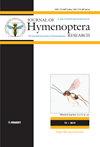西伯利亚蛾种群调节因子——卵寄生蜂Telenomus tetratomus(Thomson,1861)的抗寒性研究
IF 1.4
3区 农林科学
Q2 ENTOMOLOGY
引用次数: 0
摘要
西伯利亚蛾是欧亚大陆北部针叶林的一种危险害虫,在导致西伯利亚蛾爆发的因素中,减少食虫的调节影响被认为是重要的。一种最有效的害虫丰度调节剂是卵拟寄生蜂Telenomus tetratomus (Thomson, 1861)。有一种确定的观点认为,四爪蛾的抗寒性不如西伯利亚蛾的毛虫,而且这种害虫的爆发是由寒冷的冬季引起的,在寒冷的冬季,蛾毛虫可以忍受低温和低积雪深度,但会导致寄生蜂死亡。然而,四足绦虫的致死温度是60多年前在一个控制不充分的实验中确定的。我们评估了四爪蟾的一个抗寒性特征——过冷点(SCP),这是以前没有测量过的。寄主和寄生蜂都在过冷的状态下越冬,而冰冻对两者都是致命的。四爪蛾的平均SCP(-21.2±0.2°C)比西伯利亚蛾的平均SCP低6.3°C。通过对不同温度下的SCP分布和死亡率的比较,我们初步估算出黄蜂50%的死亡温度约为-16°C。通过对不同类型针叶林凋落物温度的分析和已发表的资料表明,寄主及其主要寄主在越冬期间因抗寒性差异而非同步死亡,可谨慎考虑西伯利亚蛾大规模繁殖爆发的原因。本文章由计算机程序翻译,如有差异,请以英文原文为准。
On cold hardiness of the egg parasitoid wasp Telenomus tetratomus (Thomson, 1861) (Hymenoptera, Scelionidae) – a population regulator of the Siberian moth
Among the factors contributing to the initiation of outbreaks of the Siberian moth, a dangerous pest of the coniferous forests of Northern Eurasia, it is considered important to reduce the regulatory impact of entomophages. One of the most effective regulators of the pest abundance is the egg parasitoid wasp Telenomus tetratomus (Thomson, 1861). There is an established opinion that T. tetratomus is less cold-resistant than caterpillars of the Siberian moth, and outbreaks of the pest are provoked by cold winters, during which conditions (low temperatures and low snow cover depth) are tolerated by the moth caterpillars but lead to death of the parasitoid. However, the lethal temperature for T. tetratomus was determined in an insufficiently controlled experiment more than 60 years ago. We evaluated one of the cold hardiness characteristics of T. tetratomus, the supercooling point (SCP), which had not been measured previously. Both the host and the parasitoid overwinter in a supercooled state, and freezing is lethal to both. The mean SCP of T. tetratomus (-21.2±0.2 °C) was found to be 6.3 °C lower than the SCP of Siberian moth caterpillars. Comparison of SCP distributions and mortality rates at several temperatures allows us to tentatively estimate 50% mortality temperature of the wasp – about -16 °C. The obtained result, analysis of temperatures in the litter of various types of coniferous forests, and published data indicate that the asynchronous mortality of the host and its main parasitoid during wintering, due to differences in cold hardiness, can be considered as the cause of outbreaks of the Siberian moth mass reproduction only with caution.
求助全文
通过发布文献求助,成功后即可免费获取论文全文。
去求助
来源期刊
CiteScore
2.60
自引率
15.40%
发文量
68
审稿时长
>12 weeks
期刊介绍:
The Journal of Hymenoptera Research is a peer-reviewed, open-access, rapid online journal launched to accelerate research on all aspects of Hymenoptera, including biology, behavior, ecology, systematics, taxonomy, genetics, and morphology.
All published papers can be freely copied, downloaded, printed and distributed at no charge for the reader. Authors are thus encouraged to post the pdf files of published papers on their homepages or elsewhere to expedite distribution. There is no charge for color.

 求助内容:
求助内容: 应助结果提醒方式:
应助结果提醒方式:


